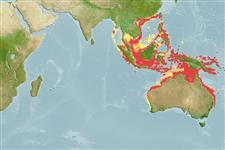Environment: milieu / climate zone / profondeur / distribution range
Écologie
marin; eau douce; saumâtre démersal; profondeur 0 - 100 m (Ref. 6871). Tropical; 28°N - 32°S, 76°E - 165°E (Ref. 114953)
Indo-West Pacific: Thailand to New Guinea and the Solomon Islands, south to Australia. Records from the south coast of India, Sri Lanka, Bangladesh, and Myanmar need confirmation.
Length at first maturity / Taille / Poids / Âge
Maturité: Lm 165.0, range 150 - 180 cm
Max length : 270 cm TL mâle / non sexé; (Ref. 9909)
Occurs inshore and offshore, from the intertidal to offshore continental and insular shelves (Ref. 9909). Young individuals are found inshore on sand flats, around atolls, and in mangrove swamps, estuaries and coastal lagoons (Ref. 6871). Adults occur inshore, over continental shelf, to ~100 m deep, and also the only rhinobatid reportedly able to live and breed in freshwater (Ref. 6871, 127960). Feeds on shellfish, mainly on crustaceans, prawns and crabs (Ref. 9909, Ref. 114953) and also small bony fishes (Ref. 127960). Ovoviviparous (Ref. 50449). Maturity size at 150-180 cm TL; born at 38-40 cm TL (Ref. 114953). Probably the major commercial guitarfish in the Western Central Pacific (Ref. 9909). Caught regularly by demersal tangle net fisheries operating throughout the area. Utilized for its meat, fins (both very high value), skin and cartilage (Ref. 58048). Reported to attain a maximum length of 4 m (Ref. 58784).
Life cycle and mating behavior
Maturité | Reproduction | Frai | Œufs | Fécondité | Larves
Exhibit ovoviparity (aplacental viviparity), with embryos feeding initially on yolk, then receiving additional nourishment from the mother by indirect absorption of uterine fluid enriched with mucus, fat or protein through specialised structures (Ref. 50449). Born at 38-40 cm TL (Ref.58048).
Last, P.R. and J.D. Stevens, 1994. Sharks and rays of Australia. CSIRO, Australia. 513 p. (Ref. 6871)
Statut dans la liste rouge de l'IUCN (Ref. 130435: Version 2025-1)
Utilisations par l'homme
Pêcheries: intérêt commercial mineur; Aquarium: Commercial
Outils
Articles particuliers
Télécharger en XML
Sources Internet
Estimates based on models
Preferred temperature (Réf.
123201): 25.7 - 29, mean 28 °C (based on 1126 cells).
Phylogenetic diversity index (Réf.
82804): PD
50 = 0.5020 [Uniqueness, from 0.5 = low to 2.0 = high].
Bayesian length-weight: a=0.00389 (0.00141 - 0.01074), b=3.05 (2.82 - 3.28), in cm total length, based on LWR estimates for this (Sub)family-body shape (Ref.
93245).
Niveau trophique (Réf.
69278): 3.6 ±0.50 se; based on food items.
Résilience (Réf.
120179): Faible, temps minimum de doublement de population : 4,5 à 14 années (Fec assumed to be <100).
Fishing Vulnerability (Ref.
59153): Very high vulnerability (90 of 100).
🛈
